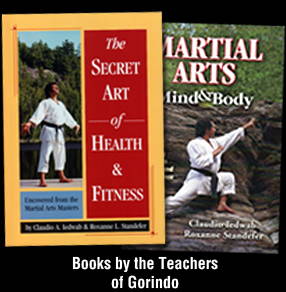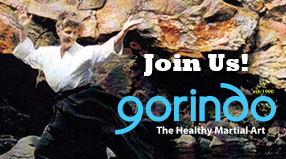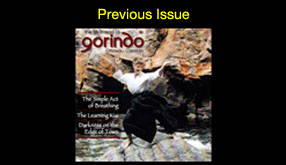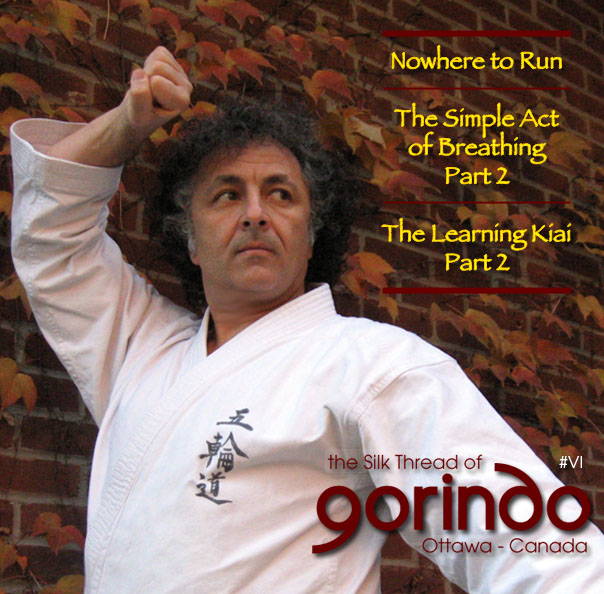
The Silk Thread of Gorindo - Ottawa - Canada
Issue VI
- The Simple Act of Breathing (Part 2)
Photo cover Claudio Iedwab sensei, Gorindo School of Martial Art
The Learning Kiai (Part 2)
< read Part 1 (previous issue)
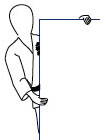
Beginning any new activity, especially with new people, can be an exciting or even frightening experience. The martial arts, by their very nature, their history, and an occasionally distorted reputation, can be intimidating to the outsider. An important part of the Learning Kiai for the beginner is summoning the courage for the first step they take inside the dojo. This Japanese word means: “a place to study or follow the way” and it shows a measure of respect for any place where students have come to learn the martial arts. The newcomer has many questions. Depending on what has motivated them to visit a martial arts school, and the accuracy of what they know about the purpose of the arts; they may begin the training with many preconceived notions. Their state of mind can be fearful, confused or occasionally defensive and even arrogant. The martial arts have been around a long time, and it is better for the beginner to treat them with respect and recognize that the traditions may be foreign to their understanding.
If the head of the school treats his or her own way of life as a profession, rather than a business, they will expect the same in their students, and that can sometimes be difficult for the modern Western consumer to accept. While many schools in America promote themselves in the same manner as a fitness club and offer similar amenities, some do not, and there may be differences in approach and attitude. For example, one school may regard fees paid as tuition for instruction, another as membership dues in a club or monies to support the facility. Rarely can an instructor charge what the true value of the teachings may be. After all, the student will be learning techniques that could save their life or that of someone they love. Most people who stay in the training for a while state that it has had a profound impact on their lives. As students progress, their relationship to the school, and that of the teacher towards them, will change.
Part of what makes martial arts work as a system for training the mind and body is a willingness to accept the relationship of student to a teacher. The tradition of the martial arts is the transmission of knowledge from a long line of teachers. The student must be receptive and open to what the teacher has to offer, and suspend somewhat the expectations that he has carried to the training. The beginner also needs to learn how to learn.
The Japanese word for this mind set is nyuanshin, and although it is usually referred to as beginners mind, this definition can be misleading. People rarely wish to be identified as a beginner, and in fact will go to great lengths to cover up weakness or error; but in the martial arts this “label” carries more respect and tradition than you might expect. In the East, a clean beginning, like the blank slate or white canvas, is an opportunity on which to build. Nonetheless, the standard definition may not do justice to all that the concept of nyuanshin has to offer to both the beginning and advanced student of the martial arts. Indeed, any endeavor that requires a willingness to learn and an open mind can benefit from this idea. It is this union of process and attitude which we are referring to as the Learning Kiai.
This state of mind is what allows real learning to occur. It enables the martial arts practitioner to observe and understand the functions of the body; its physical manifestations, and the mysterious ebbs and flows of its energies. The martial arts teach that the communication goes both ways between the mind and body. If the student is to learn how to coordinate, integrate, and eventually meld their operation into a smooth union of energy (the Kiai), then he must listen and be aware.
Surprises, realizations, improvements and solutions, often come unbidden in the process of training, and an attitude of nyuanshin will allow them to be recognized and utilized when the student is ready for them. The importance of this concept to the entire framework and philosophy of the martial arts cannot be over-emphasized, and is vital to an understanding of how the training works. It is the key to unlocking the doors to the complex relationship of the mind, body, and spirit; and when discovered, can be applied to any aspect of one’s life to find enrichment and improvement.
There are many stories associated with the history and traditions of the martial arts. Some have become legends, and are strongly influenced by the philosophy of Zen, which uses fables and questioning koan to illustrate, educate and sometimes frustrate those who wish to follow its teachings. One of the common traditions is the turning away of the beginner who presents himself at the gate of the temple, eager to learn all that he can, right away. Although this “turning away” is much less common in the modern martial arts, (replaced by a more welcoming courtesy and perhaps influenced by a need to pay the rent); the school still has a responsibility to ensure that the prospective student wishes to learn for the right reasons. The head instructor must protect his other students from those who refuse to play by the rules, and also protect society from bullies and psychopaths who should not be equipped with skills that could be misused and cause harm. The practical application of the martial arts must be taken very seriously. It is an important reason for the respectful traditions of the direct transmission of knowledge from teacher to student, and also is the background to some of the secrecy associated with its history.
Another popular story is the one about the new student who asks his teacher how long it will take to become a master. In modern times the question is usually: “When do I get my Black Belt?” The answer, inevitably accompanied with a shrug is: “It depends, maybe three to five years if you work very hard.” The eager pupil, keen to show his commitment will reply: “But I’ll work twice as hard as anybody, you’ll see! How long will it take me then?” The teacher, nonplused, answers: “In that case, 6 to 10 years, I expect.” The student, confused by this, exclaims: “No, no, you don’t understand. That’s far too long. I intend to train and train and fight and win, and I won’t think or do anything else but martial arts until I achieve mastery. How long then?” The teacher, sadly having heard it all before, quietly states: “Twenty years then, or in your case, maybe never!”
A better question is: “how long do you train in martial arts?” The true answer is: “until you die”. This illustrates that the study of martial arts is about more than acquiring a new skill, or another accomplishment for the athlete to hang on his wall. The study of a Do is a way of life, and if pursued with energy and discipline, will offer rewards and experiences far beyond the simple pleasures of trophies and record times. This doesn’t mean that everyone who begins training will continue forever, or that someone shouldn’t begin a martial arts class unless they are prepared to make that commitment. It merely points out that if you get on the path, find a good teacher and apply yourself. You will discover a great deal more than you thought existed. There is a lifetime of learning available in the martial arts, and centuries of knowledge to explore.
Of course, the beginner doesn’t know this yet. The beginner cannot know what he doesn’t yet know, and fortunately, in the martial arts no one expects him to. The white belt beginner is in a very privileged position within the system. He doesn’t yet have responsibilities other than to show up for class, be respectful, open his eyes, ears and mind, and try what the teacher suggests to him. It is definitely okay to make mistakes or to not know what to do.
Schools will vary in their attitudes about the traditions of the martial arts. The head instructor, or founder of the style, will set the tone for how traditions are to be interpreted, and what changes will be made to adapt to modern conditions or new research. It is important for the student to recognize that a healthy school is also in a continual process of change, learning, and adaptation. It is a community, and its success is a function of the energy that the teachers and students bring to it. The sensei and seniors have many years of experience, and their methods may not at first be clear to the beginner.
Recognizing and cultivating the Learning Kiai is not only a challenge for beginners. it is an ongoing part of the Gorindo program. It is mostly a function of attitude and patience, and in that sense is thought of as a process of the mind. Since the learning that must be done is rooted so profoundly in the physical, however, the development of this Kiai shows itself in all aspects of technique, fitness and endurance.
Stiffness in the body often reflects rigidity of mind, for example, and until the student learns to let go a little and relax with his own abilities, progress can be very slow.
Beginners come to the training with many apprehensions and they are mostly about their own capacity to perform and respond. They need to be assured that nobody is out to hurt them, they will not be challenged to fight the black belts, and they do not have to do their senior’s laundry. The beginner still finds it difficult to accept that their best effort will be sufficient and no one is laughing at them. Trust in the teacher and a friendly cooperative attitude in the dojo is very important in making the newcomer welcome, but it is just as important for all students at any level. Difficulties, challenges and frustrations occur at many points along the path. If a method for accepting and overcoming them is not taught as a technique alongside the skills of blocking, kicking and redirecting an attack; then it is not martial art that is being studied, but merely fighting. It is of little use outside the arena of a confrontation and therefore is of little use at all.
Martial art is about learning how to learn, and about getting the most out of your existence in the universe. With this understanding, the student will be able to learn from many sources and distill what is important and useful. This ability to distinguish will improve as the training proceeds and as long as it is kept in balance with nyuanshin, the student will be able to accept more and more of the responsibility for his own progress, and assist the teacher in helping others find their own way.
Excerpt from “Martial Arts Mind & Body” by Claudio Iedwab & Roxanne Standefer. See also their e-books available at askSensei.com >>
Illustration by © Claudio Iedwab
- The Simple Act of Breathing (Part 2)
« Click the Subscribe link on the left

